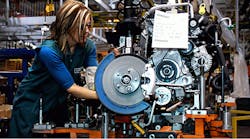A robust traded sector economy is essential to U.S. global competitiveness, and a strong manufacturing base is central to traded sector strength, as I have noted previously.
Unfortunately, manufacturing in the United States has lost competitive advantage in the last 15 years and unless this turns around significantly it will continue to be a drag on our efforts to fully recover from the Great Recession.
There is no inherent reason the United States could not run a significant trade surplus in manufacturing. America possesses the tools, talent, and resources to revive industrial production and our innovation economy.
But to do so we need a national strategy for manufacturing renewal that focuses on a cohesive set of polices, as opposed to the hodgepodge of disjointed and often contradictory efforts currently being undertaken by multiple levels of government.
We need a game plan that helps American manufacturers compete and win in the global economy.
There are three main reasons a comprehensive manufacturing strategy is essential to long term economic health. First, manufacturing generates spillover effects that benefit the rest of the economy. The knowledge needed to create new products, processes, and organizational forms cannot be contained completely within an individual establishment. It inevitably spills over to other businesses and individuals, who can use it without paying the costs of creating it.
While this provides broader social value, it also causes businesses to underinvest in R&D because they cannot capture all of the benefits. Government investments can close this research gap while boosting private sector investment in innovation.
In addition, government programs like the Manufacturing Extension Partnership can boost innovation at small and medium sized enterprises (SMEs), which are less likely than larger establishments to take advantage of innovation spillovers through the implementation of new technology, adoption of modern manufacturing processes, and investment in workforce training. In fact, every $1 of investment in the MEP program leads to $32 in economic growth.
Maintaining Innovation
Second, losing market share in knowledge-based industries has a deleterious effect on the entire economy. If a country loses its aerospace or computer chip industries to foreign competitors, the innovation capacity and knowledge base connected to those industries often disappears or follows manufacturing establishments overseas.
This reduces the overall strength of a nation’s innovation ecosystem and hampers new business development and technology generation. In addition, once the technical capacity in a particular field is hollowed out it is nearly impossible to “reshore” that industry at a later date. These “ripple effects” greatly inhibit growth throughout the economy and further hamper competitiveness in other industries, leading to additional erosion of global market share.
A national manufacturing strategy would help U.S. industries stay on the cutting-edge of emerging technologies, enhance overall knowledge generation and thereby prevent economy-wide erosion of innovation capacity even if some market share is lost to overseas competitors.
Finally, competition for innovation-based growth has globalized and intensified—particularly for increasingly globally mobile investments in high-tech R&D and manufacturing facilities.
Though it’s still vitally important, it’s simply not enough anymore for states or nations to focus solely on costs through lowering taxes, cutting regulations, and reducing energy use, after all Silicon Valley is one of America’s most fertile innovation areas but operates in a high cost environment. Rather, nations must develop an institutional environment that supports innovation, technological change, and entrepreneurial drive by investing in targeted policies and programs that both spur high-growth entrepreneurship and enhance the innovation potential of existing enterprises.
A significant reason for the erosion of our manufacturing sectors has been the result of comprehensive strategies by foreign nations to enhance domestic industries. Sometimes this has taken the form of unfair trade practices, such as currency manipulation and IP theft, which are designed to give domestic producers a competitive advantage over international competitors.
Increasingly though, nations are also implementing uniform innovation policies designed to spur national manufacturing growth. Governments in China, Germany, Japan, and Korea, among others, are directly supporting targeted industries with hundreds of millions of dollars for R&D, technology transfer and workforce training that far exceeds comparable U.S. government investment.
These nations also offer competitive tax environments including generous R&D tax credits; provide incentive packages to attract internationally mobile capital investment; and are increasing investment in programs designed to enhance the productive and innovative capabilities of manufacturers of all sizes.
Going forward, American manufacturers will increasingly find themselves at a disadvantage in international markets against establishments from countries backed by effective national strategies designed to give their companies an edge.
To allow our manufacturers to compete on a level playing field the federal government must create a national strategy that targets key industries and technologies, addresses protectionist trade policies and provides the investment, infrastructure and innovation support necessary to compete in global markets. This is the only way the United States can once again become an attractive location for manufacturing investment and growth.




